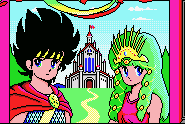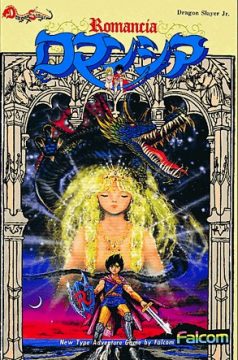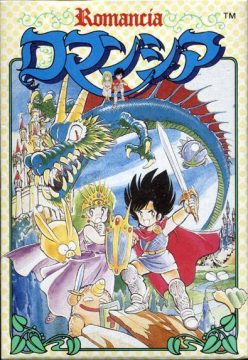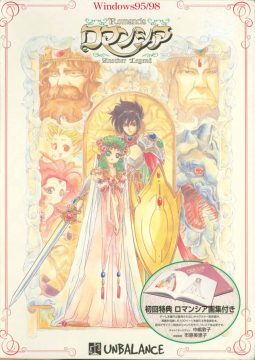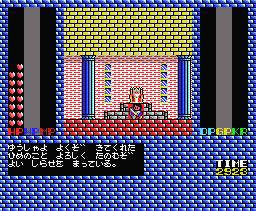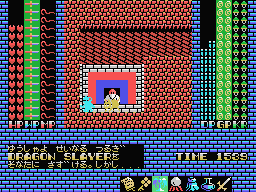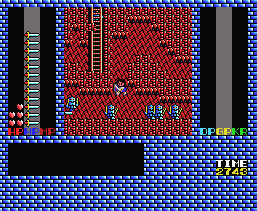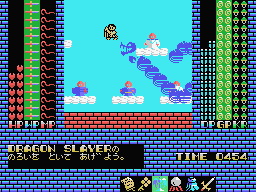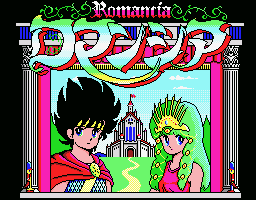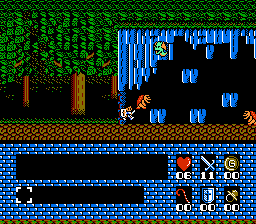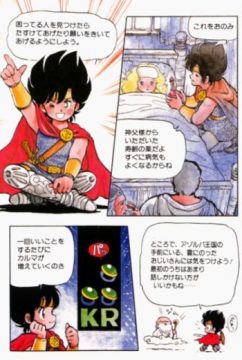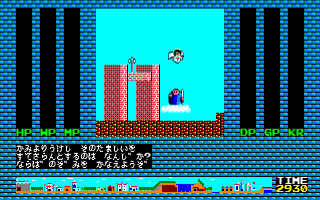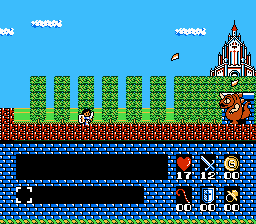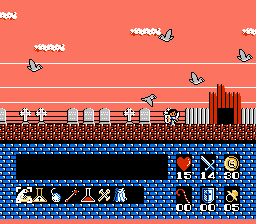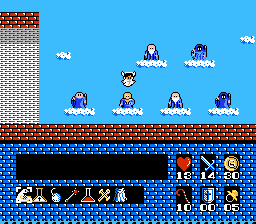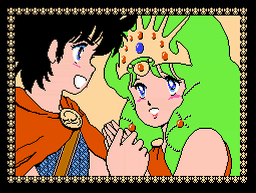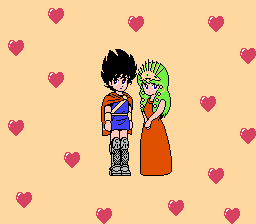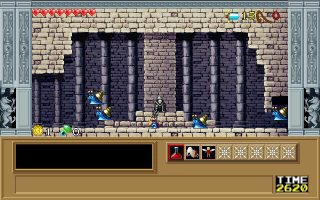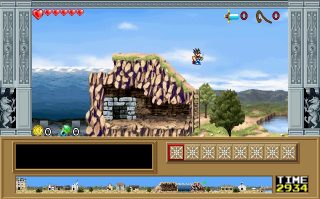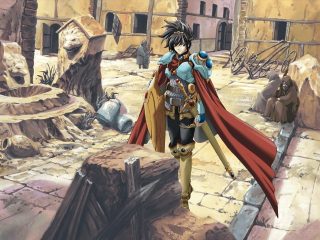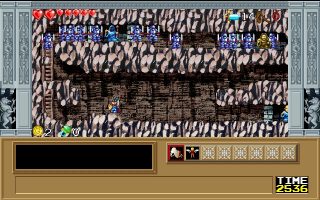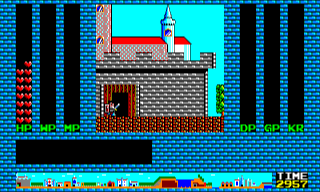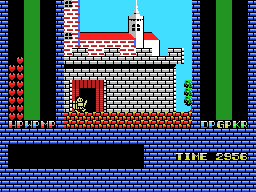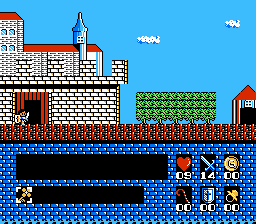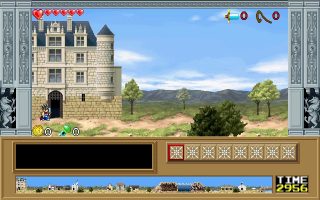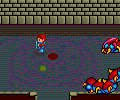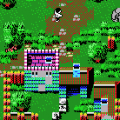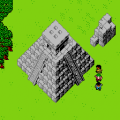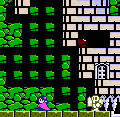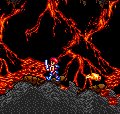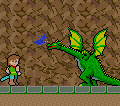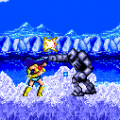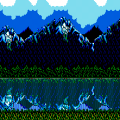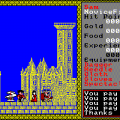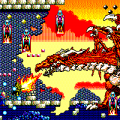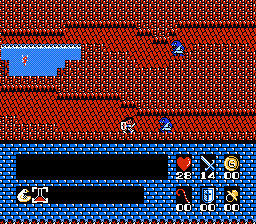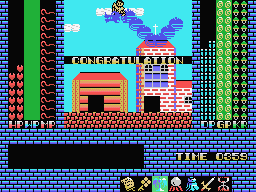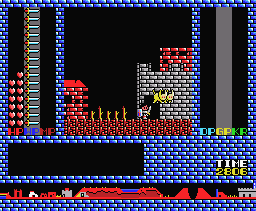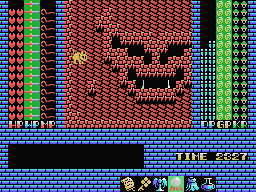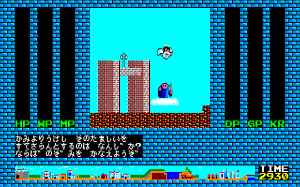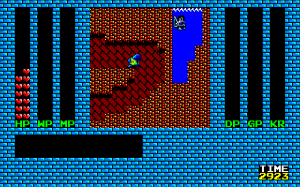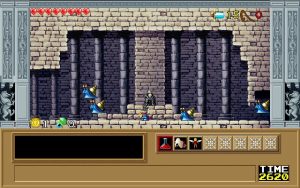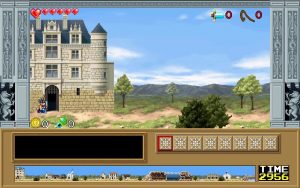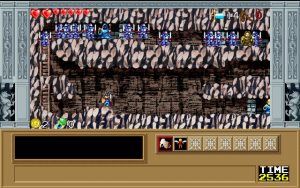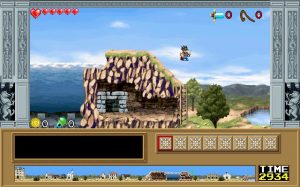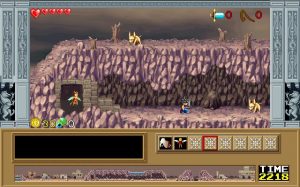Romancia, a side scrolling action adventure initially released in 1986, is the third of Falcom’s Dragon Slayer line, which were all designed and programmed by Yoshio Kiya. The story focuses on the neighboring kingdoms of Romancia and Azoruba. While they once lived in harmony, Azoruba has kidnapped Princess Selina of Romancia, which has led to a disease to fall over the land. Prince Fan Freddy, an adventurer from another land, is the last hope to save both countries. The goals are two-fold: first to rescue the Princess, and second, to obtain the Dragon Slayer sword and defeat the dragon Vaides. The title and the name of the hero comes from Guillaume-Hyacinthe Bougeant’s story Voyage du Prince Fan-Federin dans la romancie.
The game has the subtitle Dragon Slayer Jr., although that certainly doesn’t imply that it’s meant for kids. The tag-line in Japan was “Kawaisa amatte, muzukashisa 100%” – “Full of cuteness, 100% difficulty”. It’s just that, compared to deep dungeon crawling antics of Xanadu, it’s less dark, and the statistics commonly associated with role playing games have been scaled back. All of the character customization from Xanadu is gone – in fact, all of the numerical data has been simplified into icons on the sides of the screen, indicating health, “weapons” (the number of times you can throw projectiles), magic power, defense, gold, and karma. You have only thirty minutes to beat the game (though the timer does reset once you rescue the princess), and there’s absolutely no way to save your progress.
Romancia also has an incredibly small game world. There’s the town of Romancia (and associated castle), the rather ominous neighboring kingdom of Azoruba, its castle, and an expansive underground cavern that consists of an incredibly irritating maze. And other than a few small areas, that’s pretty much it. Most of the time is spent running back and forth, performing various quests, receiving items, and eventually making your way farther into the game world.
Like many older computer games, Romancia is almost hilariously cruel. If you talk to the king too many times at the beginning of the game, he’ll chide you for wasting time and reduce the clock to fifteen minutes, forcing you to either start over or really hurry up. It’s easy to find yourself in situations where you can never beat the game, due to talking to the wrong people or using the wrong items. The game package includes a manga which outlined the basic idea of what you’re supposed to be doing, but there are barely any clues to figure out what to do or where to go within the game itself. It’s just a matter of stumbling around or randomly guessing until you figure out a solution. There is an option to continue after dying (hit “X” on the Game Over screen), but it doesn’t help you if you get stuck in an unwinnable state.
One of the townspeople in Romancia is a man sitting in a cloud, will offer to send you to heaven. If you talk to him more than once at the beginning, he will literally kill you. One of the first major goals is to find the outfit that lets you enter heaven without actually dying. This is because most of the important items are granted by group of wise men who live in the clouds. They don’t grant these items to just anyone though, so the other major goal is to raise your karma. This is generally done by performing good deeds, like ferrying medicine back and forth between the church and the sick townspeople, and curing the town’s poisoned water supply.
In some respects, Romancia is a little more like an adventure game than an RPG. You collect gold, but there’s not much to do with it beyond healing yourself or buying “defense points” to absorb damage. In fact, outside of a few screens and the battle against the final boss, the game actively discourages combat. The denizens of Azoruba appear to be monsters, but they’re actually cursed civilians, and dispatching them will decrease your karma, which is in preciously limited supply. The proper way to approach them is by curing them, but you can only do that by, again, finding the right items. Certain areas can only be accessed based on the timer too.
When you do need to fight, you’ll run into some irritating issues. Most notably, the prince is annoyingly difficult to control. Your sword is incredibly short, and it’s practically impossible to kill much of anything without getting walloped. By holding down the attack button, you can shoot a projectile, which is more effective but can only be used a certain number of times. Additionally, you’re left defenseless and unable to attack again until this projectile leaves the screen. There’s no invulnerability time when you get hit, so it’s all too easy to get bumped into a corner or juggled in between bad guys until you die. Since there’s no jump button, you need to press Up to jump, which is completely maddening in the few sections that require some semblance of precision. You can double jump, but again, this is incredibly trick to pull off. This is particularly true in the “Hell” screen you fall into if you end up in the wrong part of the maze, requiring that you climb out.
The title theme music, the best song in the game, was composed by Yuzo Koshiro. The rest of the music was provided by Takahito Abe, and isn’t quite as good. The theme song of the town of Romancia is hilariously upbeat considering how frustrating the game actually is.
Romancia is a difficult game to enjoy. Without the huge levels of its brethren, its depth is quite lacking, and has too much fetch questing and not enough exploration. It’s the quintessential 80s “obscure for the sake of obscure” RPG, and while trying to outwit it is somewhat amusing, it’s also extremely difficult to actually enjoy. It was probably created since Xanadu‘s success was attributed to how hard the game was, and how often it was featured in strategy guides in computer game magazines. Still, it’s well regarded for its technical prowess: for the disk versions, the game never stops to load after you begin the game, meaning the core is less than 64kb in size. Plus, the game was completely developed over the course of about a month. Early Falcom may not have developed the most approachable games, but they were programming wizards. The character designs, by manga artist Tsuzuki Kazuhiko, are also fairly attractive.
Some elements from the game were used in later Falcom titles. Sorcerian (the fifth Dragon Slayer game) even features a scenario named “Romancia” that contains some of the same stages and characters, one of the few times that the Dragon Slayer series actually crosses over. In the late stages of the game, you need to turn yourself into a pig, which makes you invincible to enemy attacks. This concept was re-used in Ys II and Legacy of the Wizard / Dragon Slayer IV.
Other than some minor graphical differences, the home computer versions are essentially the same. The PC-88, PC-98 and X1 games are mostly identical, while the MSX versions have different (and worse) graphics. The MSX2 version offers a hidden option to play as the Princess. The scrolling and movement in all of these versions is very choppy, as typical of these machines.
Romancia was also ported to the Famicom by Compile and published by Toyko Shoseki. Although the gameplay is basically the same as the computer versions, the game world is much larger, and there’s a slightly larger focus on action. For instance, instead of starting in the town, you need to go through a forest and defeat a boss first. The layout of some areas and some of the puzzles are either different or completely removed. In general, the game is also slightly easier, especially since the timer is gone, plus there’s an item that lets you resurrect from death a handful of times. There’s actually some invincibility time after you get hit, and enemies drop health power-ups.
However, that doesn’t mean they made the game any less obtuse. Right at the beginning, you encounter an impassable door. To defeat this, you need to hunt down a specific enemy type – there are three – and repeatedly kill them until you get an orb. As usual, there are no clues about any of this in the game. Additionally, once you enter heaven, you cannot return to earth unless you’ve found a soul in the graveyard area, which is another new screen. There are only six souls in the game, so if you use too many of them, you’re stuck.
There’s also some extra music to fit with the new areas. The music and sound effects sound a lot like other Compile games like Zanac and The Guardian Legend, and actually sound better than a lot of the original Falcom music.
Despite reworking the structure, at the core, it’s still the same basic game. The graphics haven’t really improved, and are actually worse in spots, and you still need to press Up to jump. While the movement is smoother, the prince walks annoyingly slow, and combat is still incredibly clumsy. The playing field has been expanded to include the entire horizontal width of the screen, instead of being displayed in a window, though the status bar is still pretty large, and the map from the computer versions is missing. There is a new ending, at least.
Both of the MSX versions, as well as the Famicom version, have been fan translated into English. The MSX versions were done by msx.translations. The Famicom version, done by DvD Translations, goes several steps beyond merely translating the text, but also implements bug fixes, re-activates items and options that were dummied out, rewrites the dialogue to give extra guidance, and adds a character that will give you extra souls, removing one of the dead-man-walking scenarios. It’s also impressive from a technical standpoint, given that it’s one of the few NES fan translations with a variable width font. The amount of work taken to turn a nearly-unplayable game into a marginally-less-unplayable game shows true devotion to this little oddity.
In 1999, Unbalance remade the game for Windows 98 under the name Romancia: Another Legend. It comes with a 100-page hardcover book with a ton of new artwork, although about half of it consists of blank pages, oddly enough. The game itself is a pretty straight port of the PC versions, right down to the obnoxious controls. The graphics have improved drastically, rendered in 256 color SVGA, but still look weak compared to Falcom’s own Ys Eternal or Sorcerian Forever games. There’s some new artwork when you talk to certain people, which looks pretty nice, and it’s even accompanied by some voice acting. One of the voices is even provided by famed seiyuu Maaya Sakamoto (Escaflowne) as the voice of Selina.
Unbalance also composed lot of new music, but it’s all MIDI and pretty underwhelming. At least you can save at any time. In addition to a small artwork gallery, there’s a narration mode which includes clues and other commentary at the top of the screen. While the save function alone makes this superior to the original, it’s a wonder that they didn’t at least try to fix the gameplay. The original PC-88 version is included, although it uses slightly upgraded MIDI sound instead of emulated synth.
There’s also a “choose your own adventure” book based on the game, and a drama CD released in 1991, as well as a manga. The story of the manga was by Kenji Terada, also worked on stories for the 8-bit Final Fantasy games. It flips the concept of the game, positioning Princess Selina as the protagonist, as she rescues Prince Fan Freddy.
Links:
Sorcerian Music Files – Romancia A small Japanese page about the different versions.
Romancia Walkthrough Good God, is this ever useful. In Japanese though.
Dragon Slayer Laboratory – Romancia More pics and another walkthrough, also in Japanese.
Romancia MSX Also in Japanese.
Strategy Wiki – Romancia An English walkthrough for the Famicom version.
